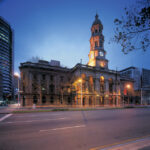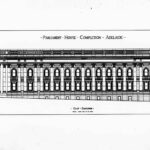In the early decades of European settlement, architecture was used as a public relations tool to project an impression of stability and prosperity to potential immigrants and investors in Britain. The legacy of that campaign can be seen among the colony’s early building stock, a high proportion of which is well designed, but rarely venturing outside orthodox English Victorian taste. The formality of that taste, combined with the geometric juxtaposition of urban subdivisions and parkland which is William Light’s legacy, gives much of Adelaide and North Adelaide a character unlike that of any other Australian city. George Strickland Kingston produced a number of distinctive public buildings and private houses with the Mediterranean climate in mind, but had little continuing influence; official and commercial buildings by architects such as Edmund Wright and Thomas English were almost always in one of the Victorian classical revival styles. Collaboration between Wright and Edward Woods produced some notable designs, their Town Hall and GPO clock towers which frame the northern entrance to Victoria Square providing one of the more dramatic statements of South Australian architecture. Domestic architecture was mostly in stone, and not strikingly different from that of the eastern capitals, except that less pressure for land meant that there are few terrace houses in Adelaide. Most ecclesiastical architecture was conventionally gothic, enlivened by the strength of dissenting Protestantism with its rejection of the gothic style favoured by the Church of England; hence such striking buildings as the mannerist Congregational church on Brougham Place, North Adelaide, and the large Baptist churches at North Adelaide and suburban Leabrook, Norwood and Semaphore. Before high-rise buildings came to dominate the skyline, Adelaide was often known as the ‘city of churches’, reflecting the visual prominence of church towers in a very flat city. There has probably never been a time when Adelaide had more churches than hotels, but ‘city of pubs’ was not an image that the colonial fathers encouraged.
South Australia’s slender economic base has always made it susceptible to cyclical fluctuations, and a large proportion of the historic building stock dates from short periods of exceptional prosperity, such as the great boom of the late 1870s and early 1880s. Nineteenth-century architects had a strong preference for stone masonry, although some such as Woods and George Soward did distinctive early work in brick. William McMinn was a talented architect who died young. His strongest legacy is probably a fondness for the Scottish Baronial style, evident in such grand houses as Mount Breckan at Victor Harbor, Marble Hill in the Adelaide Hills (now a ruin) and the eponymous Torrens Park (now Scotch College). Victorian Tudor buildings such as Prince Alfred College at Kent Town (McMinn with Daniel Garlick) also have a distinctively Scottish flavour. Federation architecture was taken up enthusiastically by Garlick, Frederick Dancker, and the practice of English & Soward, and the turn of the twentieth century saw some robust red brick designs such as Henry Cowell’s Adelaide Fruit and Produce Exchange in the east end of the city, Dunn and Fuller’s Stock Exchange in McHenry Street, and the Museum North Wing and School of Mines on North Terrace, both by Charles Edward Owen Smyth (the superintendent of public buildings, 1886–1920).
In the twentieth century, American stylistic influences replaced English ones, both in the new commercial office towers of the city centre and domestic bungalows in the Californian and neo-Tudor styles in new suburbs like Colonel Light Gardens and Toorak Gardens. These provoked nostalgic reactions such as Kenneth Milne’s Georgian revival designs. Formal registration of architects began in 1939, when architectural teaching was dominated by figures such as Louis Laybourne Smith, who for 40 years was head of architecture at the School of Mines (now the University of South Australia). Modernism made a tentative appearance in the late 1930s, but had its full impact only after the 1950s, and a style known as Adelaide Regional was identifiable in the next few decades. Some landmark buildings of the past 70 years have been Fitzgerald and Brogan’s Adelaide Boys’ High School in the West Parklands, Jack McConnell’s Bank of New South Wales in King William Street and the former David Jones department store in Rundle Mall, Rod Roach’s Metropolitan Fire Service headquarters in Wakefield Street and Guy Maron’s Bicentennial Tropical Conservatory in Adelaide Botanic Garden. In the modern era, South Australian architecture has become completely internationalised. The period since 1980 has seen Adelaide lose much of its local character, as the city centre filled with high-rise office blocks, and historically derivative styles pervaded the new suburban housing.






Comments